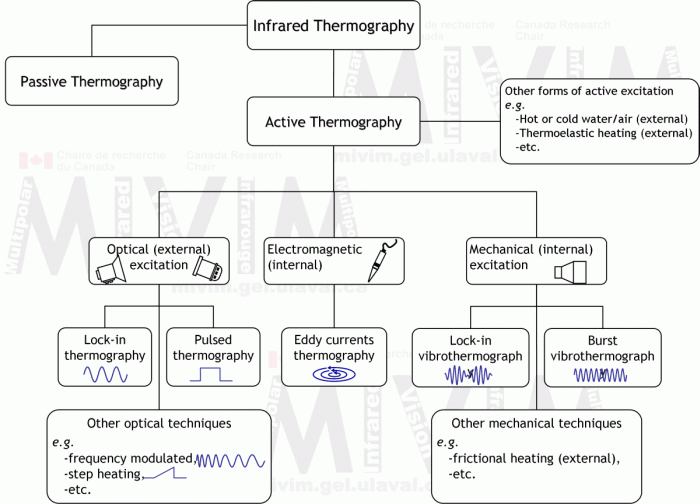


Infrared Thermography is a NonDestructive Testing and Evaluation (NDT&E) technique, i.e. an inspection method for the examination of a part, material or system without impairing its future usefulness [MALD01b]. When compared with other classical NDT&E techniques such as Ultrasonic Testing or Radiographic Testing, data acquisition by infrared thermography is safe, nonintrusive and noncontact, allowing the detection of relatively shallow subsurface defects (a few millimeters in depth) under large surfaces (typically 30x30 cm2 at once, although inspection of larger surfaces is possible) and in a fast manner (from a fraction of a second to a few minutes depending in the configuration, see below).
There are two approaches in infrared thermography as seen in Figure 2: (1) passive, in which the features of interest are naturally at a higher or lower temperature than the background, e.g. surveillance of people on a scene; and (2) active, in which an energy source is required to produce a thermal contrast between the feature of interest and the background, e.g. a specimen with internal flaws. The active approach is adopted in many cases given that the inspected parts are usually in equilibrium with the surroundings.

A wide variety of energy sources can be used to induce a thermal contrast between defective and non-defective zones that can be divided in external, if the energy is delivered to the surface and then propagated through the material until it encounters a flaw; or internal, if the energy is injected into the specimen in order to stimulate exclusively the defects. Typically, external excitation is performed with optical devices such as photographic flashes (for heat pulsed stimulation) or halogen lamps (for periodic heating), whereas internal excitation can be achieved by means of mechanical oscillations, with a sonic or ultrasonic transducer for both burst and amplitude modulated stimulation. As depicted in Figure 2, there are three classical active thermographic techniques based on these two excitation modes: lock-in (or modulated) thermography and pulsed thermography, which are optical techniques applied externally; and vibrothermography, which uses ultrasonic waves (amplitude modulated or pulses) to excite internal features.
Last update: Wednesday, November 21, 2007
cic